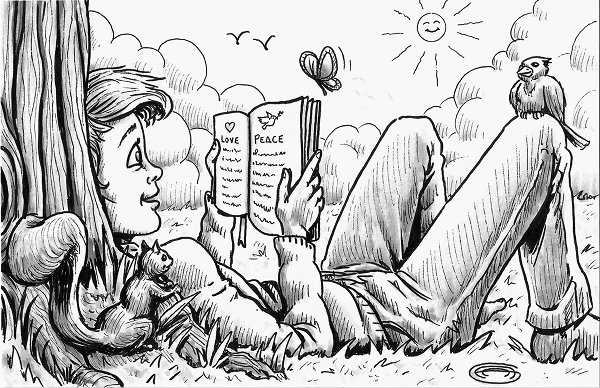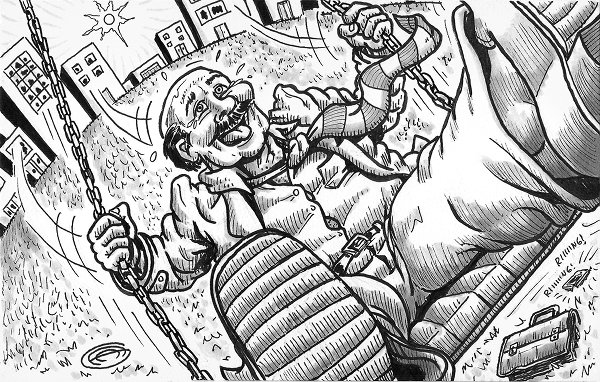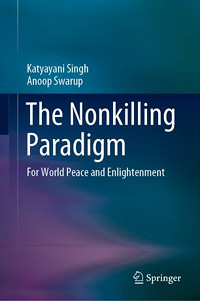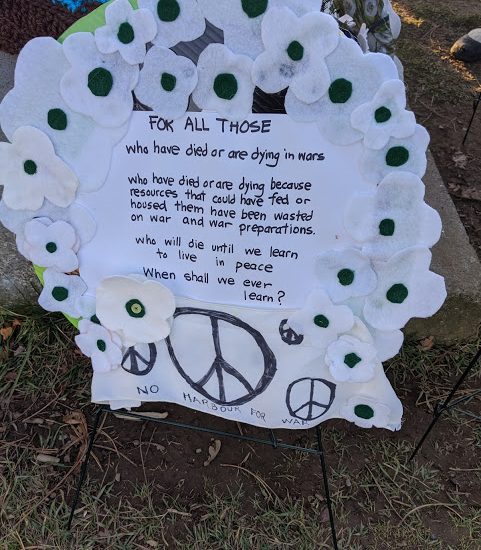|
|
|
|
|
|
|
|
"Nonkilling art explores the spirit and practice of how to prevent, respond to, and to improve individual, social, and global well-being beyond killing." —Glenn D. Paige
|
|
Dear NKARC members and friends,
|
The New Year is about new beginnings and visions of hope and understanding, in this case working towards a Nonkilling world. It is amazing how seven years have passed when we began with our first NKARC letter in April 2012.
|
|
Thank you for your contributions; as always these are eclectic and inspirational, awakening our passion to prevent violence, and connect with life.
|
|
|
|
1. Nonkilling Poetry
The four poems below attempt at a new history of humanity - singing the joy of life, a humanity made planetary, not inflicting pain on others and others not inflicting pain upon you, showing an optimism that elevates the dignity of a peaceful life.
|
For Humanity
by Francisco Gomes de Matos
|
One day in the not-too-distant future, by all governments/nations, a Global Peace Treaty will be signed!
To all signatories, a dual mission will be assigned:
|
|
1.1. All children as peace co-builders will be educated.
|
2. All global citizens will be ensured of enjoying their multi-right to:
Diplomatic harmony.
Economic dignity.
Environmental sustainability.
Healthcare accessibility.
Mutilingual interactivity.
Sharing scientific/technological innovations.
Spiritual serenity.
|
In short, by honoring the Global Peace Treaty, all governments/nations will be co-writing a new history for Humanity!
Prof. Gomes de Matos is a peace linguist, Recife, Brazil.
|
Life and humanity: Poem in two parts
By Christophe Barbey
|
I will sing for you …
I will sing – for you – the joy of life,
The bliss of the moment,
The pleasure of lasting …
|
I will sing – for you, for all – the knowledge of life,
Joy in simplicity,
Knowledge in care …
|
I will sing – for all – the wisdom of love,
Every instant made our living creation,
Reaching the good of all …
|
I will sing – in all as in you – the deepness of our hearts,
Profundity of every touch
Merging in humanity …
|
I will sing – by all – the blessing body
Delight in health, well-being shared,
The reach and fullness of ecstasy …
|
We will sing – all in all – our humanity,
Expression of our happy qualities,
Made planetary, infinitely.
|
There was a job to be done,
And I did it.
It was not too much of a hard job:
Nurturing the best,
Leaving the rest,
Paying my dues with some fair work,
Leaving no one behind,
Self-paying myself with high pleasure.
|
You can do it too,
Or you can help,
Though we are all equal,
In love and wisdom,
And freedom,
All given to all.
|
It is, it was, after all,
An easy job,
To let life
Naturally springing through us,
Humanly living,
Life at its best.
|
Poem in unity
Humanity is life
Christophe Barbey is the Center for Global Nonkilling’s Main Representative at UN HRC in Geneva.
|
Citizen of Dark Times
by Kim Stafford
|
Agenda in a time of fear: Be not afraid.
When things go wrong, do right.
Set out by the half-light of the seeker.
For the well-lit problem begins to heal.
Learn tropism toward the difficult.
We have not arrived to explain, but to sing.
Young idealism ripens into an ethical life.
Prune back regret to let faith grow.
When you hit rock bottom, dig farther down.
Grief is the seed of singing, shame the seed of song.
Keep seeing what you are not saying.
Plunder your reticence.
Songbird guards a twig, its only weapon a song.
|
Kim Stafford is Oregon‘s poet laureate who lives in Portland, Oregon, USA.
|
The PEACEpower of NON
By Francisco Gomes de Matos, Recife, Brazil
|
When to NONviolence we commit
No forms of harm we permit
When to NONkilling we commit
No forms of killing we admit
|
When NONviolence and
NONkilling we advocate
The DIGNITY of a PEACEFUL
LIFE we elevate
|
|
|
|
2. Nonkilling Play
|
‘Master Harold’ ...and the Boys by Athol Fugard
|
South Africa’s prolific protest playwright Athol Fugard, now aged 87, has been working in the theatre as a playwright, director, and actor in his homeland, England and USA for over 50 years. In November, 2011 he received a Lifetime Achievement Tony Award. He began writing during the country’s apartheid times and is a strong believer that the arts has a major role to play in transforming the society and the country he has lived in.
|
His play "Master Harold...and the boys” is one of his earliest plays set in 1950 South Africa during apartheid era, it depicts how institutionalized racism, bigotry or hatred can become absorbed by those who live under it. It is seen in this play through the relationship of two middle aged black servants working in a tea room with their white teenage ‘master’ Harold, the Hally, giving the play its title. It is regarded as a semi-autobiographical play, as Fugard's birth name was Harold and his boyhood was very similar to Hally's, including his father being disabled, and his mother running a tea shop to support the family.
|
Jack Klaff in his introduction of Fugard, the play, and the South African protest theatre in the program notes of its latest production at the National Theatre in London, UK writes an insightful comment: “Though it is the work of a consummate artist at the height of his powers, it is also autobiographical to the point of painful vulnerability. As a child Fugard had a family servant called Sam who was a father figure to him. One day Fugard , younger in real life than Hally is in the play, did something to Sam which is replicated in the play. It was a shameful act, one which he could perform without fear of reprisal because of racial divide.
|
Fugard castigates himself in the play...turning private shame into a shattering public event. He quotes Adrienne Rich on Emily Dickson, saying that ‘what is under most pressure to be concealed explodes into poetry’.”
|
Yes, it is that sensitivity and his care with words which underlies Fugard’s plays that brings out in place of conventional polemics a nuanced understanding of hope and reconciliation, a key element in Nonkilling exploration of drama.
|
Athol Fugard adapted the play for a television movie produced in 1985, directed by Michael Lindsay-Hogg with stars, Matthew Broderick, Zakes Mokae, and John Kani.
{ Watch the movie (1hr29mts) }
|
|
|
|
3. Nonkilling Conceptual Art and Design
MOMA’s Minesweeper Sphere Installation by Afghan Dutch artist Massoud Hassani
From Wikipedia: Massoud Hassani studied Industrial Design at Design Academy Eindhoven, and inspired by homemade wind-powered toys he made during his childhood, he and his brother created the Mine Kafon wind-powered landmine machine—Kafon means "explode" in Dari. The machine, which looks like a giant dandelion puff ball that rolls across areas of land and detonates landmines, was created for his 2011 graduation project. Made of bamboo, iron, and plastic, the design that was inspired by a starburst was a finalist in London's Design Museum's 2012 Design of the Year Award. Called a visual poem by the New York Times, it was exhibited in 2013 at the Museum of Modern Art in New York City and the following year at "The Fab Mind: Hints of the Future in a Shifting World" design exhibition as one of the "socially and politically engaged designs."
|
Massoud Hassani was born in Afghanistan, where there are an estimated 10 million mines buried in about 500 square kilometres (190 sq mi). He and his brother, Mahmud, in fear of the landmines, took a special path to school. Massoud says, that knowing that there are buried landmines left their by departing armies "becomes like a mental disorder.. The fear is on your mind all the time." As children, the boys made wind-driven toys to play with around the Kabul deserts, but they would get stuck in the middle of minefields.
|
|
|
|
4. Nonkilling Doc Cinema
Doukhobors of Saskatchewan (90 min)
I first read about pacifist Doukhobors as an example of a nonkilling community in Glenn D. Paige’s book, Nonkilling Global Political Science. Later that reference introduced me to Doukhobor scholar and researcher Koozma J. Tarasoff and his website ‘spirit-wrestlers.com’. In June 1895, the Doukhbors burnt their arms in protest to be recruited by the ruling Czar for the Russian army. Supported by novelist Leo Tolstoy, one-third of them (the most persecuted) fled Russia to Canada. Here Koozma Tarasoff introduces us to a new documentary on present day Doukhobors made by Ryan Androsoff. He writes:
|
“This is a beautiful contribution to the cultural treasure of Doukhobors in Saskatchewan. The film will be remembered by children and grandchildren for years to come. They will recall that their ancestors believed in the Spirit of God within each person (based on a deep philosophy of love, truth, hospitality, and humanity), that peace is the way to a sustained future on Planet Earth. Nonviolence or nonkilling is central. Also they will remember that the collective style of life gave their ancestors strength to survive. And this attitude will likely prevail and give the new generation strength to carry on their mission into the future.
|
Ryan Androsoff and his team are to be greatly applauded for their efforts in creating this documentary film. Fundraising was a big challenge met by Doukhobors and others. The team interviewed 30 people who said many good things. The inclusion of several young people in the interviews is an acknowledgement that the new generation expects a voice with new changes. And the intent of the film was correct — ‘to help start a conversation about the future of Doukhoborism for generations to come'.”
|
For more on the film and Doukhobors:
|
Rox C’s Reflection video (7min)
The video was embedded in a fund raising appeal for the International Campaign for Justice in Bhopal (ICJB) in which NKARC colleague playwright Rahul Varma participates annually. He fasts for 35 hours every year with other ICJB members globally from December 2 to 4 to advocate for survivors of the 1984 Bhopal, India gas disaster, regarded as the worst industrial disaster ever. If you have not heard of the Bhopal Gas Disaster, visit http://www.bhopal.net/what-happened-in-bhopal/.
|
|
The 7 min video by Rox C shows the work that she did with children in Bhopal, at the Sambhavna Trust Clinic and Chingari Rehabilitation Centre as part of her Masters degree in communications and arts. Use of the arts both text and as activity with young people in the video shows how the arts can serve as a catalyst for communication and community connections.
|
|
|
|
5. Nonkilling Futures
"The Year 2050: A Predic-scription" by Johan Galtung
The year 2050, Professor Galtung describes from his unique perspective to be an important one, “being one generation of 30 years ahead of us; neither too close, nor too far into the future, for predictions and prescriptions”. He adds that it will be realistic to assume that it will be “within the range of the probable for predictions and the feasible for prescriptions.” Looking into future just a generation away, he finds in this article signs of optimism not in unipolar/bipolar/multipolar divides but projection of a vision of universal peace in 9 contemporary civilizations.
|
|
|
|
6. Nonkilling Visual Art
Spanish Canadian artist Alberto Agraso had a vernissage of his recent art work, entitled, Beyond the Veil last month. Alberto describes his creative process as ‘Art of Spirit’ where responding to a daily challenge in the month of October artists worldwide offer their visual representation to an assigned word of the day. Alberto writes: “For me, the word begins the process of my opening up to visions and interpretations that expand the word’s meaning and allow a perspective grounded in Spirit to come through my pencil into form.”
|
|
Two illustrations selected here from his 31 ink drawings are inspired from the words Tasty and Swing transformed into Food for Soul and Joy respectively.
|
|

|

|
|
For his creative process, in his own words, see a short video (3.32 min), Spanish with English sub-titles.
|
|
|
|
7. Nonkilling Reflections
(ii) In the spirit of linking sociology with musicology, NKARC physician-poet colleague Hugh Mann offers the following distinction between EXTROVERTS & INTROVERTS:
“As social mammals, our sociability spans a continuum from extroversion to introversion. Extroverts are outgoing and talkative, while introverts are reserved and reticent. Like a musical key signature, sociability stamps each personality with either the perky sharps of extroversion or the sad flats of introversion. But despite our temperament or tempo, each of us is the composer and conductor of a solitary soul's solemn sonata seeking social solace.”
|
|
|
|
8. Nonkilling Non-Fiction
The Nonkilling Paradigm by Katyayani Singh and Anoop Swarup
Springer academic publishers has just released the new book book, The Nonkilling Paradigm: For World Peace and Enlightment. In this book, case for the creation of a ‘nonkilling world’ through a study of human history, social and political leadership has been made as nonkilling is indeed a more focused and measurable approach to human development and ascent. A comparison of violent and nonviolent leadership styles exposes a vicious cycle in our own human past that had unleashed universal hatred and distrust being ideologically corrupted, resulting in negative human actions of deceit and destruction, subjugation and killings.
|
|

|
|
|
9. Nonkilling Linguistics
|
A comprehensive biographical article about our Nonkilling poet and Peace linguist Prof. Francisco Gomes de Matos by NKARC colleague Jocelyn Wright. The article describes Prof. Gomes de Matos’ pioneering scholarly work from Human rights to Nonkilling linguistics, Jocelyn’s piece was published in recent issue of Humanising Language Teaching.
|
|
|
|
10. Nonkilling Fiction
Melvile's Moby Dick
Johan Galtung in an article on Melvile’s classic writes about the soul of America: “Herman Melville’s Moby Dick, written in 1859 (602 pp in Borders 2004 edition) is a national epos for the United States. Italy has Dante’s Divina Commedia defining Italy; Germany has Goethe’s Faust defining Germany. And the United States has Herman Melville’s Moby Dick, beautifully written with an incredibly rich vocabulary, it defines US... A national epos communicates a national ethos. He asks “so, who will win in the longer run, Man-US or Nature-Moby Dick?”
|
|
|
|
11. Nonkilling Activism
White Poppy Wreath
Casualties of contemporary wars are not just soldiers, but in fact as many as 90 percent of these are civilians, refugees, plus blind environmental destruction resulting from the act. NKARC colleague Kathrin Winkler sent along an image of one of the wreaths that she and colleagues created for "Halifax Remembers Peace: K'jipuktuk 2019", a white poppy wreath laying event on November 11 Remembrance Day. See the photo below and the description of the event from an article published in the Nova Scotia Advocate. The wreath laid reminds environmental destruction caused by wars , it was made in a local open art studio Wonderneath.
|
|

|
|
|
|
12. CGNK Updates
|
The Nonkilling Paradigm by Katyayani Singh and Anoop Swarup
|
Progress report of Centre of Global Nonkilling (CGNK) work at UN Human Rights Research Council, Geneva
|
The Universal Periodic Review as a nonkilling tool, step by step in the right direction. At UN Human Rights Council, CGNK is represented by Christophe Barbey. For report on his work at UNHRC, CGNK Director Joam Evans Pim notes: “We have a campaign in full swing calling for the universal ratification of the Genocide Convention, a convention adopted one day before the Universal Declaration of Human Rights (9th of December 1948). We started our campaign in late in 2017 and we require from all States that have not yet ratified the convention to urgently do so. 21 States out of 46 in need to do it have been challenged so far. Three of them have ratified, congratulations! 11 more agreed to do so before their next passage in front of the Council.“
|
|
|
|
13. Nonkilling Journalism
Climate Change and Consciousness Shift by Robert Koehler
Koehler writes: "There is a climate change movement growing, led by the upcoming generation — the ones whose future may be stolen. Do I have a right to feel hope in this movement, or is hope of any sort merely a cruel illusion and the punchline of dystopian humor?"
|
Brazil’s Deepening Malaise by Robert Rotberg
Rotberg notes: "Likewise, because of the breach of environmental law and regulations in the Amazon, so will the unhindered destruction there give impunity to the corporate interests that are promoting deforestation. Mr. Bolsonaro connives in that form of corruption as well, with much of the resulting profits from the clearing of the Amazon constituting abuse of public office for private gain."
|
Pope Francis’ speaks on Nuclear Disarmament in Nagasaki
Providing unflinching support of Catholic church to nuclear disarmament, Pope Francis said: “A world of peace, free from nuclear weapons, is the aspiration of millions of men and women everywhere… Our response to the threat of nuclear weapons must be joint and concerted, inspired by the arduous yet constant effort to build mutual trust and thus surmount the current climate of distrust.”
|
Envisioning a United World by Robert Koehler
Koehler writes: "Can we not look at matters from a planetary, as opposed to an us-vs.-them, perspective? Referring to the works of Danny Sjursen and Rana Dasgupta, he notes that humanity is trembling on the brink of extinction and the global political structure we’ve built is incapable of addressing or even acknowledging this. Borders are obsolete. Nationalism is obsolete; it’s been obsolete..."
|
Gandhi and Tolstoy by Ravi Bhatia
Bhatia writes: "Gandhi was greatly inspired by Tolstoy for his humanity, nonviolence, vegetarianism and other features, despite never having met him. His words reinforce his admiration: ‘Tolstoy was the greatest apostle of nonviolence that the present age has produced.’"
|
|
|
|
Last Word
Hope for the safety of a disappearing world in rumination of Roberto Juarroz’s poem:
|
To invent the return of the world
after its disappearance.
And to invent a return to this world
since our disappearance
And to reunite the two memories
together in all its details
One must submit infinity to tests
to see if it resists.
|
|
|
|
|
My deep gratitude to all who contributed and pointed to material for this Letter.
|
Look forward as always to your inspirations, suggestions and comments.
|
Nonkillling Best 2020,
Bill
|
|
"Nonkilling Culture crosses all the lines." —Glenn D. Paige
|
Nonkilling is THE measure of Human progress
|
[THIS IS AN INTERNAL NEWSLETTER OF THE NKARC. COPYRIGHT FOR ALL MATERIAL IN THE NEWSLETTER REMAINS PROPERTY OF THE SOURCES/WRITERS/ART CREATORS]
|
|
|
|
Stay in contact also on Social Networks
- Please feel free to contact NKARC Letter's coordinator at billbhaneja@nonkilling.org.
- You can also follow the Center for Global Nonkilling at these social networks:
|
 
|
|
|
|
|
|